

Its four pale stripes are greyish to white and it has two pale stripes and three brown stripes on its face. Red-tailed Chipmunks have five dark stripes, the central one running from between the ears to the tail. The tail has a black stripe and is yellowish at the tip. The back is orange-brown, the rump is grey and the underside is whitish. It is often reddish-brown on the shoulders and sides, the colour fading out towards the hips. Description: The Red-tailed Chipmunk is darker and larger than most chipmunks.Size: Approximately 60 g and around 23 cm long.1 Physical Changes in Chipmunks to Prepare for Deep Sleep. Their fur varies from tawny to pinkish-brown and their ears are whitish behind and black in front. Let’s take a look at what these are and how they help chipmunks survive in the winter. Every few days, they awaken, their body temperature rises to about 94 degrees, and they eat some of the food stored in their burrow. The pale stripes are usually white or greyish. Although these little rodents hibernate, they dont spend the entire winter in a deep sleep. They have five black stripes down the back three dorsal stripes extending from shoulder to rump and two lateral strips extending to mid-body. Description: Yellow-pine Chipmunks are small compared to other chipmunks.Whilst hibernation may sound to us like a nice break and a chance to catch up on some sleep, it can be. Their tail is bushy, dark brown and tipped with grey and brown. Squirrels dont hibernate as they dont really need to.

Their underside varies from creamy white to grey, and their ears are black in front and grey behind. They have five dark stripes alternating with four lighter stripes, and two grey and three brown stripes on their faces.
#CHIPMUNKS HIBERNATE IN WINTER PATCH#

Stay tuned for my upcoming "Beyond Your Backyard" article on crows and other corvids.Įpp is an Environmental Educator and Nature Writer based out of Moose Jaw, SK.Did you know chipmunks hibernate? They burrow in subterranean nests, waking frequently to feed on stored food. We are, after all, connected - and we share this crazy world together! They won't turn down a tasty berry, either. You can help chipmunks out by offering them foods high in fat and protein, like peanuts and pine nuts. Here in Canada, chipmunks begin to hibernate in late October to early November. Then it is kept under their nest for when they wake up and need a snack - although chipmunks eat the most food just before going into their initial hibernation. Chipmunks do not, so that is why they must store away a good supply of food. They will also store food in their nests to eat during their hibernation period. During hibernation, chipmunks will lower their body temperature and heart rate while also reducing their metabolic rate.

They will create dens or nests underground, where they will stay for weeks or even months at a time. Most hibernating animals put on extra fat to help them survive winter. Yes, chipmunks do hibernate in the winter. One nest was found with over 68,000 seeds stored under it! During winter, they go into hibernation. The winter pantry of food is kept under their nests. Now they are even more busily gathering and storing food in preparation for winter.


 0 kommentar(er)
0 kommentar(er)
